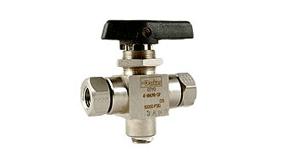There are so many different types of ball valves. If you try and search for one, you’ll be met with so many varying options that it will probably make your head hurt. So if you’re looking for guidance about the right type of ball valve for you, then you’ve come to the right place. Read on to discover what a ball valve actually is, and the differences between high and low pressure variants.
What exactly is a ball valve?
A ball valve is, surprise surprise, a type of valve that is used to control the flow of liquid or gas. In the vast world of valves, a ball valve is known as a shut off valve because it controls movement flow.
This type of valve is designed with a rotary ball at the core of its functionality. The ball has a bore (a hole) built into it to aid flow restriction.
During installation, the ball’s bore is aligned with the flow opening in the pipes to allow for a seamless flow. The handle attached to the valve controls its restrictive features. When this handle is turned by 90 degrees, the ball’s holes are closed off, thus restricting the flow of the relevant liquid or gas.
Ball valves come in a variety of shapes and sizes. Whilst most valves are 2-way and manually operated, it is possible for ball valves to have up to four ports. The ball valves which use three-four ports are more likely to be used in large scale manufacturing processes.
During installation, it is imperative that the lever is aligned with the pipe. This will ensure that the ball valve can efficiently control the rate of flow.
How do ball valves work?
It is possible for these valves to be operated by hand, but sometimes, these valves are powered using one of two power sources - pneumatic or electric. Either of these sources is delivered through an actuator which is usually found bolted to the top of the valve.
Pneumatic actuators
If a ball valve is powered using a pneumatic actuator, then the actuator receives pneumatic signals from something called a pressure pilot. This process will be powered using compressed air, or alternatively, gas. The ball valve’s position is then changed and managed in relation to the pneumatic signals that the actuator is receiving.
Electric actuators
Electric actuators work similarly, but the signals involved in this process are, as expected, electrical. They usually originate from an electric pilot. Again, the valve positions are altered based on the electric signals that are received by the actuator.
Often, electric actuators are favoured because they have two distinct advantages.
-
Automation: electric actuators can communicate position feedback which means that they are able to be controlled remotely
-
Zero-Emissions: electric actuators are considered the greener alternative to pneumatic processes. Electricity is used in favour of natural gas which means that no emissions are released into the air whilst the actuator is monitoring the valve.
Ball valves are known for their extensive service life and reliable sealing. One of the best things about these valves is that they typically retain these features even when they’re not used for a long period of time.
High pressure ball valves vs low pressure ball valves
Whilst they both perform the same function, high pressure ball valves and low pressure ball valves are typically used for different applications and within different industries.
High pressure ball valves
High pressure ball valves are typically used in systems that require a reliable shut off power. These ball valves are popular in the oil and gas industries. Common uses across these industries include suction controllers, back pressure valves and recirculation valves.
Usually, these valves are used for connections to mains input as they are designed to operate at maximum working pressures of 500 PSI and above. They can work at this intensity without any fear of damaging the valve body or jeopardising the valve’s functionality.
As a result, high pressure ball valves are commonly used in the following industries:
-
Gas pipelines
-
Hydraulics systems
-
Agricultural machinery
-
Chemical and petrochemical industries
-
Mining industry
-
Offshore water high pressure cleaning systems
From a design perspective, a high pressure ball valve has a smaller bore built into the ball. This design is optimised for high intensity environments.
Low pressure ball valves
Low pressure ball valves are typically used for appliances rather than for direct mains use. For example, low pressure ball valves are often used for toilets, as the water flow is provided by gravity rather than the mains. As a result, the water pressure is lower.
These ball valves are in popular use where long term reliability is a determining factor. As a result, low pressure ball valves are popular within the Oil, Gas and Petrochemical industries.
In opposition to their high pressure counterparts, the bore that is built into low pressure ball valves is much larger. This design allows for a faster flow to occur. In addition, if the ball valve is being used to fill something up, then the filling time is much faster compared to a high pressure valve because of this design feature.
However, this larger hole does have one annoying downside. If the pressure for your liquid flow is too high, then a low pressure ball valve can cause excessive noise. Given that low pressure ball valves are commonly used in the water industry, this is something that can easily bother clients.
If you’re looking to buy ball valves, you have a range of suppliers at your disposal. Whilst you can purchase them from the classic Amazon and eBay searches, it’s best to buy from a certified expert supplier, like Fluid Controls, because your measurement and dimensions will likely be very specific.












No Comments